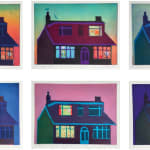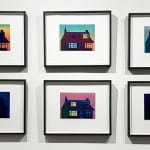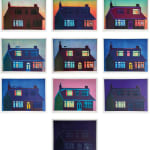A Soap Opera, 2021
Each 15 x 20 cm (image)
27 x 34 cm (sheet)
Unframed
Further images
Like many artists, despite extra time potentially afforded by the first lockdown (around home schooling) I felt stuck. The world had become too strange to penetrate. You literally couldn't make it up.
At the start of the lockdown, I had made a large painting of a house which I had called Bad TV, a reference to a line in Woody Allen's Husbands and Wives - "life doesn't imitate art it imitates bad television". The painting, loosely based on one that I see from my sitting room window also referred to our communal experience of being confined to our homes watching box sets. I had intended this painting to be the last in a body of work about suburbia and had been searching for new material but to no avail.
The beginning of the first lockdown coincided with the clocks springing forward and the return of the seagulls to our roofs, finding mates and starting families. The nights when the clocks change in the very north of England are bewitching. They glow with colour well into the night. The luminous scenes from my sitting room window began to hijack my attention as I sat watching the bewildering news of the unfolding pandemic. Every night I watched and made drawings.
And finally, I realised that my subject matter was here, about being stuck both as artist and the wider experience of the lockdown. In December of 2020 I started to work on a series of 10 aquatints called A Soap Opera. The series of prints depict one house, lights turning on and off, illuminating pictures, mirrors, curtains, a Louis XI fireplace, photos on the mantel piece. Night descends, but the time is ambiguous, not entirely linear. Christmas comes in the dead of night, the paintings change. The painting in the bottom window is (loosely) based on two Gainsborough images, The Blue Boy and Mrs Graham.





